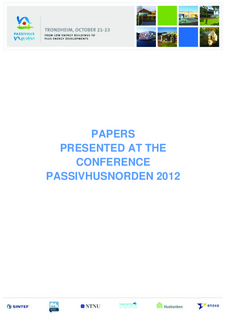| dc.description.abstract | Several Nordic countries have a long tradition for timber frame building, especially in small houses, but also in larger buildings with load bearing concrete constructions, as filled in wooden structures in the main facades. Therefore, to improve the marked share for Passive houses, it is crucial to develop guidelines for energy efficient timber frame constructions, suitable for northern climate conditions and building traditions. Climatic conditions and architectural traditions differ between regions. Hence, it is important, but not enough to look at solutions in other countries. A lot of “German” or “Austrian” solutions or building materials could be used in Nordic countries too, but they may be difficult to introduce due to different building traditions. Climatic conditions between Norwegian average climate and Central-European average climate differs not as much as most of us think. On the other hand – there are much bigger climatic differences within Norway. The temperature varies more between mild coast and cold inland than between south and north. In addition, there are large regional and local variations concerning rain, wind and solar conditions. The paper will report the results of a research project called “Passive House solutions based on timber frame constructions”, which dealt with state of the art analyses concerning wooden constructions used in Passive House projects in Norway, Sweden, Germany and Austria. A literature review of research reports and existing guidelines are also carried out. The main observations are discussed with regard to different climate conditions and relevance for the Norwegian building industry. The paper will give an overview of used constructions and main distinctions between the mentioned countries as well as examples on possible solutions for different climate conditions, ensuring good indoor climate and avoiding moisture problems. One observation within the study is that some constructions in Sweden are more different Norwegian solutions than Central-European solutions are, for instance use of EPS between two layers of mineral wool, or steel sections in wooden wall structures. Both in Sweden, Germany and Austria, foundation and slab on ground constructions differs considerably from solutions in Norway. Another difference is that there is little focus on wind protection in these countries, which is crucial in exposed locations in Norway. And last not least: Exposure to very much rain and wind some places on the coast in Norway makes it necessary to accept a compromise between low thermal bridge values around windows and rain protection in such cases. This emphasizes how important adapted solutions for Passive Houses are. The project was mainly funded by Innovation Norway. As an outcome, it was developed guidelines within the series “Fokus på Tre” and “SINTEF Building Research Design Guides”. Basic detail drawings will be shown in the presentation. | |
